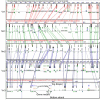Genome of the long-living sacred lotus (Nelumbo nucifera Gaertn.)
- PMID: 23663246
- PMCID: PMC4053705
- DOI: 10.1186/gb-2013-14-5-r41
Genome of the long-living sacred lotus (Nelumbo nucifera Gaertn.)
Abstract
Background: Sacred lotus is a basal eudicot with agricultural, medicinal, cultural and religious importance. It was domesticated in Asia about 7,000 years ago, and cultivated for its rhizomes and seeds as a food crop. It is particularly noted for its 1,300-year seed longevity and exceptional water repellency, known as the lotus effect. The latter property is due to the nanoscopic closely packed protuberances of its self-cleaning leaf surface, which have been adapted for the manufacture of a self-cleaning industrial paint, Lotusan.
Results: The genome of the China Antique variety of the sacred lotus was sequenced with Illumina and 454 technologies, at respective depths of 101× and 5.2×. The final assembly has a contig N50 of 38.8 kbp and a scaffold N50 of 3.4 Mbp, and covers 86.5% of the estimated 929 Mbp total genome size. The genome notably lacks the paleo-triplication observed in other eudicots, but reveals a lineage-specific duplication. The genome has evidence of slow evolution, with a 30% slower nucleotide mutation rate than observed in grape. Comparisons of the available sequenced genomes suggest a minimum gene set for vascular plants of 4,223 genes. Strikingly, the sacred lotus has 16 COG2132 multi-copper oxidase family proteins with root-specific expression; these are involved in root meristem phosphate starvation, reflecting adaptation to limited nutrient availability in an aquatic environment.
Conclusions: The slow nucleotide substitution rate makes the sacred lotus a better resource than the current standard, grape, for reconstructing the pan-eudicot genome, and should therefore accelerate comparative analysis between eudicots and monocots.
Figures




Similar articles
-
Practical halving; the Nelumbo nucifera evidence on early eudicot evolution.Comput Biol Chem. 2014 Jun;50:75-81. doi: 10.1016/j.compbiolchem.2014.01.010. Epub 2014 Jan 26. Comput Biol Chem. 2014. PMID: 24525373
-
The sacred lotus genome provides insights into the evolution of flowering plants.Plant J. 2013 Nov;76(4):557-67. doi: 10.1111/tpj.12313. Epub 2013 Oct 11. Plant J. 2013. PMID: 23952714
-
The NnCenH3 protein and centromeric DNA sequence profiles of Nelumbo nucifera Gaertn. (sacred lotus) reveal the DNA structures and dynamics of centromeres in basal eudicots.Plant J. 2016 Sep;87(6):568-82. doi: 10.1111/tpj.13219. Epub 2016 Aug 2. Plant J. 2016. PMID: 27227686
-
Benzylisoquinoline Alkaloids Biosynthesis in Sacred Lotus.Molecules. 2018 Nov 6;23(11):2899. doi: 10.3390/molecules23112899. Molecules. 2018. PMID: 30404216 Free PMC article. Review.
-
Comprehensive Analysis for GRF Transcription Factors in Sacred Lotus (Nelumbo nucifera).Int J Mol Sci. 2022 Jun 15;23(12):6673. doi: 10.3390/ijms23126673. Int J Mol Sci. 2022. PMID: 35743113 Free PMC article. Review.
Cited by
-
Current Advances in the Metabolomics Study on Lotus Seeds.Front Plant Sci. 2016 Jun 20;7:891. doi: 10.3389/fpls.2016.00891. eCollection 2016. Front Plant Sci. 2016. PMID: 27379154 Free PMC article. Review.
-
Thioredoxin o-mediated reduction of mitochondrial alternative oxidase in the thermogenic skunk cabbage Symplocarpus renifolius.J Biochem. 2019 Jan 1;165(1):57-65. doi: 10.1093/jb/mvy082. J Biochem. 2019. PMID: 30289493 Free PMC article.
-
Time-course analysis and transcriptomic identification of key response strategies to complete submergence in Nelumbo nucifera.Hortic Res. 2022 Feb 11;9:uhac001. doi: 10.1093/hr/uhac001. Online ahead of print. Hortic Res. 2022. PMID: 35147174 Free PMC article.
-
Paleopolyploidies and Genomic Fractionation in Major Eudicot Clades.Front Plant Sci. 2022 May 31;13:883140. doi: 10.3389/fpls.2022.883140. eCollection 2022. Front Plant Sci. 2022. PMID: 35712579 Free PMC article.
-
Thermal-stable proteins of fruit of long-living Sacred Lotus Nelumbo nucifera Gaertn var. China Antique.Trop Plant Biol. 2013 Sep 1;6(2-3):10.1007/s12042-013-9124-2. doi: 10.1007/s12042-013-9124-2. Trop Plant Biol. 2013. PMID: 24363819 Free PMC article.
References
-
- Shen-Miller J. Sacred lotus, the long-living fruits of China Antique. Seed Sci Res. 2002;14:131–143.
-
- Shen-Miller J, Schopf JW, Harbottle G, Cao RJ, Ouyang S, Zhou KS, Southon JR, Liu GH. Long-living lotus: germination and soil g-irradiation of centuries-old fruits, and cultivation, growth, and phenotypic abnormalities of offspring. Am J Bot. 2002;14:236–247. - PubMed
-
- Duke JA, Bogenschutz-Godwin MJ, duCellier J, Duke AK. Handbook of Medicinal Herbs. 2002. Boca Raton: CRC Press.
-
- Diao Y, Chen L, Yang G, Zhou M, Song Y, Hu Z, Lin JY. Nuclear DNA C-values in 12 species in Nymphaeales. Caryologia. 2006;14:25–30.
Publication types
MeSH terms
Associated data
Grants and funding
LinkOut - more resources
Full Text Sources
Other Literature Sources
Molecular Biology Databases
Miscellaneous

